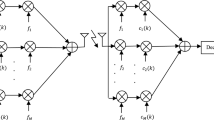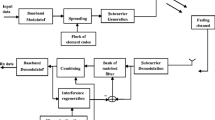Abstract
The ideal correlation properties of single user code division multiple access (CDMA) systems with complementary codes (CC) are lost by multiple access interference and near–far effects in downlink frequency selective fading channels. This severity in interference has motivated to develop ways to overcome the threats with suitable suboptimal interference cancellation schemes. In this paper, we propose successive interference cancellation (SIC) for downlink CDMA systems with CC to improve the system capacity and reduce error rate under near–far situations. Theoretical study and extensive simulations were conducted to verify the effectiveness of proposed SIC under frequency selective Rician fading channels in achieving frequency diversity gain, close to theoretical lower bound in complementary coded CDMA (CC-CDMA) systems.










Similar content being viewed by others
References
Sari, H., Karam, G., & Jeanclaude, I. (1995). Transmission techniques for digital terrestrial TV broadcasting. IEEE Communication Magazine, 33(2), 100–109.
Tseng, C. C., & Liu, C. L. (1995). Complementary sets of sequences. IEEE Wireless Communications, 18(5), 644–652.
Golay, M. J. E. (1961). Complementary series. IRE Transactions on Information theory, 72(2), 82–87.
Chen, H. H., Yeh, J. F., & Suehiro, N. (2001). A multicarrier CDMA architecture based on orthogonal complementary codes for new generations of wideband wireless communications. IEEE Communication Magazine, 39(10), 126–135.
Chen, H. H., Chiu, H. W., & Guizani, M. (2006). Orthogonal complementary codes for interference free CDMA technologies. IEEE Wireless Communications, 13(1), 68–79.
Chen, H. H. (2007). The next generation CDMA technologies. Hoboken: Wiley.
Chen, H. H., Chu, S. W., Kuroyanagi, N., & Vinck, A. J. H. (2007). An algebraic approach to generate a superset of perfect complementary codes for interference-free CDMA. Wireless Communications and Mobile Computing, 7(5), 605–622.
Meng, W. H., Sun, S. Y., & Chen, H. H. (2013). Multiuser interference cancellation in complementary coded CDMA with diversity gain. IEEE Wireless Communication Letters, 2(3), 303–306.
Liu, Z., Guan, Y. Z., & Chen, H. H. (2015). Fractional delay resilient receiver design for interference free MC-CDMA communication based on complete complementary codes. IEEE Transactions on Wireless Communications, 4(3), 1226–1236.
Mohammed, M., & Buehrer, M. (2008). The effects of ordering criteria in linear successive interference cancellation in CDMA system. IEEE Transaction on Wireless Communications, 7(11), 4128–4132.
Judson, D., & Albert Raj, A. (2016). Performance of multicarrier complementary-coded CDMA under frequency-selective Nakagami-m fading channels. Eurasip Journal on Wireless Communications & Networking. https://doi.org/10.1186/s13638-016-0563-y.
Sun, S. Y., Hu, Y. L., Chen, H. H., & Meng, W. X. (2016). Joint pre-equalization and adaptive combining for CC-CDMA systems over asynchronous frequency-selective fading channels. IEEE Transactions on Vehicular Technology, 65(7), 5175–5184.
Judson, D., & Bhaskar, V. (2017). Error rate analysis of SIMO-CDMA with complementary codes under multipath fading channels. Wireless Personal Communications. https://doi.org/10.1007/s11277-017-4938-0.
Benvenuto, N., & Bisaglia, P. (2003). Parallel and successive interference cancellation for MC-CDMA and their near–far resistance. In Proceedings of IEEE Vehicular Technology Conference, pp. 1045–1049.
Fang, L., & Milstein, L. B. (2000). Successive interference cancellation for multicarrier DS/CDMA. IEEE Transactions on Communications, 48(9), 1530–1540.
Miridakis, N. I., & Vergados, D. D. (2013). A survey on the successive interference cancellation performance for single-antenna and multiple-antenna OFDM systems. IEEE Communications Surveys and Tutorials, 15(1), 312–335.
Andrews, J., & Meng, T. (2003). Optimum power control for successive interference cancellation with imperfect channel estimation. IEEE Transactions on Wireless Communications, 2(3), 375–383.
Hossein-Abed, H. M., Nezambadi-Pour, H., Moghadam, D. A., & Khademi, M. (2013). Joint detection, channel estimation and interference cancellation in downlink MC-CDMA communication systems using complex-valued multilayer neural networks. Annals of Telecommunications, 68(7), 467–476.
Proakis, J. G. (2001). Digital communication (4th ed.). New York: McGraw-Hill.
Judson, D., Bhaskar, V., & Selvaraj, K. (2017). Pre-equalization schemes for MIMO CC-CDMA systems over frequency-selective fading channels. Wireless Personal Communications. https://doi.org/10.1007/s11277-017-4936-2.
Chen, H. H., & Chiu, H. W. (2004). Design of perfect complementary codes to implement interference-free CDMA systems. Proceedings of IEEE GLOBECOM, 2, 1096–1100.
Verdu, S. (1998). Multiuser detection. UK: Cambridge University Press.
Madkour, M. F., Gupta, S. C., & Wang, Y. P. E. (2002). Successive interference cancellation algorithms for downlink W-CDMA communication. IEEE Transactions on Wireless Communications, 11(1), 169–177.
Saxena, J., Rai, C. S., & Bansal, P. K. (2007). Near–far resistant ICA based detector for DS-CDMA systems in the downlink. Wireless Personal Communications, 43(2), 341–353.
Wang, C., Au, E., Munch, R., Mow, W. H., Cheng, R., & Lau, V. (2007). On the performance of MIMO zero-forcing receiver in the presence of channel estimation error. IEEE Transactions on Wireless Communications, 16(3), 805–810.
Author information
Authors and Affiliations
Corresponding author
Additional information
Publisher’s Note
Springer Nature remains neutral with regard to jurisdictional claims in published maps and institutional affiliations.
Rights and permissions
About this article
Cite this article
Judson, D., Bhaskar, V. Interference Cancellation in CDMA Systems Employing Complementary Codes Under Rician Fading Channels. Wireless Pers Commun 101, 897–914 (2018). https://doi.org/10.1007/s11277-018-5732-3
Published:
Issue Date:
DOI: https://doi.org/10.1007/s11277-018-5732-3




